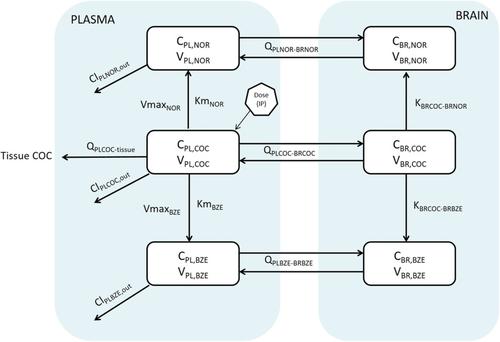当前位置:
X-MOL 学术
›
Genes Brain Behav.
›
论文详情
Our official English website, www.x-mol.net, welcomes your
feedback! (Note: you will need to create a separate account there.)
Pharmacokinetic and pharmacodynamic analyses of cocaine and its metabolites in behaviorally divergent inbred mouse strains
Genes, Brain and Behavior ( IF 2.4 ) Pub Date : 2020-05-08 , DOI: 10.1111/gbb.12666 Jing Zhu 1 , Ryan J Beechinor 1, 2 , Trey Thompson 1 , Allison N Schorzman 1 , William Zamboni 1, 3 , Daniel J Crona 1, 3, 4 , Daniel L Weiner 1 , Lisa M Tarantino 1, 5
Genes, Brain and Behavior ( IF 2.4 ) Pub Date : 2020-05-08 , DOI: 10.1111/gbb.12666 Jing Zhu 1 , Ryan J Beechinor 1, 2 , Trey Thompson 1 , Allison N Schorzman 1 , William Zamboni 1, 3 , Daniel J Crona 1, 3, 4 , Daniel L Weiner 1 , Lisa M Tarantino 1, 5
Affiliation

|
Cocaine (COC) is a psychostimulant with a high potential for abuse and addiction. Risk for COC use disorder is driven, in part, by genetic factors. Animal models of addiction‐relevant behaviors have proven useful for studying both genetic and nongenetic contributions to drug response. In a previous study, we examined initial locomotor sensitivity to COC in genetically diverse inbred mouse strains. That work highlighted the relevance of pharmacokinetics (PK) in initial locomotor response to COC but was limited by a single dose and two sampling points. The objective of the present study was to characterize the PK and pharmacodynamics of COC and its metabolites (norcocaine and benzoylecgonine) in six inbred mouse strains (I/LnJ, C57BL/6J, FVB/NJ, BTBR T+ tf/J, LG/J and LP/J) that exhibit extreme locomotor responses to cocaine. Mice were administered COC at one of four doses and concentrations of cocaine, norcocaine and benzoylecgonine were analyzed in both plasma and brain tissue at 5 different time points. Initial locomotor sensitivity to COC was used as a pharmacodynamic endpoint. We developed an empirical population PK model that simultaneously characterizes cocaine, norcocaine and benzoylecgonine in plasma and brain tissues. We observed interstrain variability occurring in the brain compartment that may contribute to pharmacodynamic differences among select strains. Our current work paves the way for future studies to explore strain‐specific pharmacokinetic differences and identify factors other than PK that are responsible for the diverse behavioral response to COC across these inbred mouse strains.
中文翻译:

行为不同的近交系小鼠品系中可卡因及其代谢物的药代动力学和药效学分析
可卡因 (COC) 是一种精神兴奋剂,极有可能被滥用和成瘾。COC 使用障碍的风险部分是由遗传因素驱动的。事实证明,成瘾相关行为的动物模型对于研究遗传和非遗传对药物反应的贡献非常有用。在之前的一项研究中,我们检查了遗传多样性近交系小鼠品系对 COC 的初始运动敏感性。这项工作强调了药代动力学 (PK) 在 COC 初始运动反应中的相关性,但受到单剂量和两个采样点的限制。本研究的目的是表征 COC 及其代谢物(去甲可卡因和苯甲酰爱康宁)在六种近交小鼠品系(I/LnJ、C57BL/6J、FVB/NJ、BTBR T+ tf/J、LG/J)中的 PK 和药效学特征。和 LP/J)对可卡因表现出极端的运动反应。小鼠被给予四种剂量之一的COC,并在5个不同时间点分析血浆和脑组织中可卡因、去甲可卡因和苯甲酰爱康宁的浓度。对 COC 的初始运动敏感性被用作药效学终点。我们开发了一种经验性群体 PK 模型,可同时表征血浆和脑组织中的可卡因、去甲可卡因和苯甲酰爱康宁。我们观察到脑区室中发生的菌株间变异可能导致选定菌株之间的药效学差异。我们目前的工作为未来的研究铺平了道路,以探索品系特异性药代动力学差异,并确定 PK 以外的因素,这些因素导致这些近交系小鼠品系对 COC 的不同行为反应。
更新日期:2020-05-08
中文翻译:

行为不同的近交系小鼠品系中可卡因及其代谢物的药代动力学和药效学分析
可卡因 (COC) 是一种精神兴奋剂,极有可能被滥用和成瘾。COC 使用障碍的风险部分是由遗传因素驱动的。事实证明,成瘾相关行为的动物模型对于研究遗传和非遗传对药物反应的贡献非常有用。在之前的一项研究中,我们检查了遗传多样性近交系小鼠品系对 COC 的初始运动敏感性。这项工作强调了药代动力学 (PK) 在 COC 初始运动反应中的相关性,但受到单剂量和两个采样点的限制。本研究的目的是表征 COC 及其代谢物(去甲可卡因和苯甲酰爱康宁)在六种近交小鼠品系(I/LnJ、C57BL/6J、FVB/NJ、BTBR T+ tf/J、LG/J)中的 PK 和药效学特征。和 LP/J)对可卡因表现出极端的运动反应。小鼠被给予四种剂量之一的COC,并在5个不同时间点分析血浆和脑组织中可卡因、去甲可卡因和苯甲酰爱康宁的浓度。对 COC 的初始运动敏感性被用作药效学终点。我们开发了一种经验性群体 PK 模型,可同时表征血浆和脑组织中的可卡因、去甲可卡因和苯甲酰爱康宁。我们观察到脑区室中发生的菌株间变异可能导致选定菌株之间的药效学差异。我们目前的工作为未来的研究铺平了道路,以探索品系特异性药代动力学差异,并确定 PK 以外的因素,这些因素导致这些近交系小鼠品系对 COC 的不同行为反应。











































 京公网安备 11010802027423号
京公网安备 11010802027423号